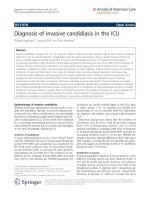Ultrasound in the ICU handout edition 1
Bạn đang xem bản rút gọn của tài liệu. Xem và tải ngay bản đầy đủ của tài liệu tại đây (1.1 MB, 36 trang )
Ultrasound in the ICU
Doug Franzen, MD, M.Ed, FACEP
Asst. Professor, Associate Residency Director
VCU Department of Emergency Medicine
Objectives
• Demonstrate how to perform and the
potential findings of various limited bedside
ultrasound studies that can be performed in
the critical care setting
• Get you more interested in incorporating
ultrasound into your practice!
You’ve Come a Long Way, Baby
You’ve Come a Long Way, Baby
Why Learn Ultrasound?
Everybody’s doing it:
• Providers of the near-future will be
incorporating bedside ultrasound as part of
an “extended physical exam”
• Has been part of EM residency training since
1994; now required by ACGME
• Medical Students are learning it as part of
their exam
• Even EMS providers are using ultrasound in
the field!
Why Learn Ultrasound?
Outperforms our usual tests:
• Better than a decubitus xray for pleural
effusion!
• Better than an AP xray for pneumothorax!
• Better than your standard physical exam for a
whole host of things
– M1’s outperformed board-certified cardiologists
“The students were significantly more accurate than the
cardiologists in the recognition of . . . LV dysfunction,
valvular disease (96% vs. 68%) . . . and in the recognition
of lesions that cause systolic or diastolic murmurs”
Why Learn Ultrasound?
• Improves safety & speed of procedures
– In one study of proceduralists in a pulmonology group (i.e.
people who do a LOT of thoracentesis), the pneumothorax
rate dropped from 8.6% to 1.1% after they incorporated
US
– A metaanalysis showed that using US for placement of
central lines led to decreases in:
• Placement failure - by 64%
• Complications - by 78%
• Need for multiple attempts - by 40%
•
Randolph, Cook, Gonzales et al. Ultrasound guideance for placement of central venous
catheters: a metaanalysis of the literature. Crit Care Med 1996; 24:2053-2058
Why Learn Ultrasound?
“ [For placing central lines,] Ultrasound
assistance was superior to landmark
techniques. Dynamic ultrasound outperformed
static ultrasound but may require more
training and personnel. All central cannula
placement should be conducted with
ultrasound assistance.” (italics added)
Milling TJ Jr, Rose J, et.al. Randomized, controlled clinical trial of point-of-care limited ultrasonography
assistance of central venous cannulation: the Third Sonography Outcomes Assessment Program (SOAP-3)
Trial. Crit Care Med. 2005 Aug;33(8):1764-9
Evaluation of Resuscitation
• Circulation
–
–
–
–
–
–
Organized activity during cardiac arrest
Pericardial Effusion / Tamponade
Pulmonary Embolus (RV strain)
(estimated) LVEF / Cardiac Output
Aortic Root & Abdominal Aorta
Volume status (IVC)
• Airway
– Endotracheal tube placement
• Breathing
– Pneumothorax
– Pulmonary Edema
– Pleural Effusion
Cardiac Arrest?
Pericardial Effusion
Effusion vs. Tamponade
RV Strain
Estimating EF
Estimating EF
• Several studies on the “eyeball” method
• Lump patients into one of three groups
– normal,
– mild-moderate decrease in contractility
– severe decrease in contractility
• Good correlation with formal echo after
minimal training
Estimating EF
Evaluate the Aorta
Evaluate the Aorta
Evaluating Volume Status
• IVC diameter & respiratory variation correlates
with CVP*
IVC size (cm)
Respiratory change
RA Pressure (cm)
< 1.5
Total collapse
0–5
1.5 – 2.5
> 50% collapse
5 – 10
1.5 – 2.5
< 50% collapse
11 – 15
> 2.5
< 50% collapse
16 – 20
> 2.5
No change
> 20
* This is from an early study…more recent studies have shown that it’s
probably not quite this clear cut.
IVC & Volume Status
Endotracheal Tube Placement
• There should only be 1 air-filled structure in
the neck if the tube is in the right place
Good
In the Goose
Thoracic US
• “Lung US scans carried out in the ED detect occult
PTX and its extension with an accuracy that is almost
as high as the reference standard (CT scanning).”
– Chest 2008; 133:204-11
• Normal pleura creates “comet tail” artifacts (AKA Blines), and motion between the two layers of pleura
can be seen as the patient breathes
• In a pneumothorax, these normal findings are lost
because air (which doesn’t play well with US) is
between the two pleural layers
Normal Pleural US
Pneumothorax in M-mode
Normal – the mixture of air and soft
tissue in the lung below the pleura
cause scatter of US, creating the
“sand” of the seahore
Pneumothorax – air between the two
layers of pleura sets up a
reverberation artifact, creating the
“barcode sign”









